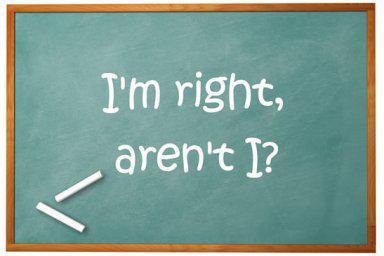
Little buggers.
I have never heaved so many sighs while grading tests as I have today. There were two parts of the test the students were apparently struggling with. The first part was asking questions in the past simple. They never used the infinitive in those questions, instead opting for the past simple of the main verb. On the upside, they did use the past simple of the auxiliary verb to do (i.e. did). I think this problem is the easier of the two to solve.
The part they had the greatest difficulties with, was the part about the question tags. For the laymen among my readers, an example:
(1) You don’t know what a question tag is, do you?
In phrase (1) the underlined part is the question tag. Notice that the first part of the sentence is negative, and the question tag is positive. Now, take a look at the second example:
(2) This confuses you already, doesn’t it?
You’ll notice in (2) that the first part of the sentence is positive and that there’s no auxiliary verb in there, only a main verb. Since it’s a main verb, you’ll need to use the verb to do in the question tag. Then you have to notice that the main verb is in the third person singular (you can deduct this from the –s at the end of the main verb). This means that you’ll have to conjugate to do into does and then you have to make it negative, turning it into doesn’t. Lastly, you have to turn the word this into the correct personal pronoun, namely it. Are you still with me? I hope so, because I’m going to move on to example (3).
(3) You can’t keep up, can you?
In the first part of this sentence there’s an auxiliary verb present (can’t). You have to use this auxiliary verb in your question tag; you only need to make it positive since the first part of the sentence was negative. Of course there’s no need to change the subject of the first part into a personal pronoun, because it already is. Easy-peasy, right? Although it would be quite useful to know what the auxiliary verbs in English are (can, could, may, will, would, shall, should, ought, must, need, might, and have). What about this:
(4) You will continue reading, won’t you?
In this sentence there’s the auxiliary will. The question tag needs to contain this auxiliary, but in the negative (abbreviated) form. So you have to know that the negative of will is won’t, not willn’t. Okay, onwards.
(5) I asked you to keep reading, didn’t I?
Examples 1 through 4 were all in the present tense. Sentence (5), however, is in the past tense. There’s only a main verb in the first part, so you have to use the auxiliary to do in the question tag. Because the first part of the sentence is in the past tense, the question tag needs to be as well. Of course, to do is an irregular verb and you should know that the past tense of the verb to do is did. After applying all this, you just need to make did into the negative form didn’t.

Oh, did I forget to mention this silly beast?
So, to be able to make your own question tags you have to ask yourself:
- Is this sentence in the present or in the past tense (know your irregular verbs!)?
- Is the first part positive or negative (know that the suffix n’t means not)?
- Do I see an auxiliary verb in the first part of the sentence (know the auxiliary verbs)?
- Is there a main verb and how do I conjugate to do in the question tag (know the third personal singular and the irregular past simple)?
- How do I change the subject into a personal pronoun if it isn’t one already (know the personal pronouns)?
My students have never been taught question tags, so they encountered them in this chapter for the first time. In this chapter they were also introduced to the irregular verbs for the first time. They don’t know what auxiliary verbs are (not even what they are in their native language – Dutch), they sometimes don’t even know what verbs are for that matter. They sometimes have trouble seeing that n’t at the end of a verb actually means not. Most of them do grasp personal pronouns, fortunately. However, most of them have difficulties with pointing out the subject in a sentence. Then there’s the positive/negative switch in the sentence they have to worry about. For my students, that’s quite a lot of things to think of at the same time. I wonder why the course book thought it was a good idea to introduce question tags in this manner (with and without auxiliary verbs and in both the present and past tense). They are making it way too complicated!
Moreover, the way the question tags in the course book are used they are only meant to invite a listener to agree with you. This can be accomplished in a different and a far less complicated way. I will demonstrate:
(6) This is complete and utter crap, right?
You see, it can’t be any simpler than this. In fact, I have paid attention to the use of question tags at college, and they are only rarely used. Most of the times, the question tag is substituted by that one little word right. Why can’t I teach my students this?
If you, by chance, have any insight on this matter, please feel free to let me know in a comment.
Advertisement Eco World Content From Across The Internet. Featured on EcoPressed
Clothing Exchanges: The Way Forward
Featured on EcoPressed
Clothing Exchanges: The Way Forward
